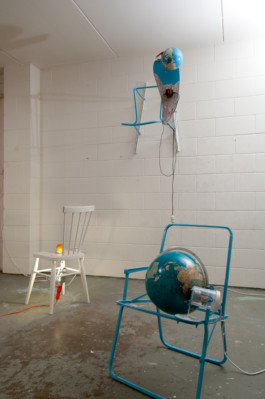Digital r/p/m proposition: four virtual exhibitions
This interactive, virtual project realised a speculative proposal made by artist Paul Cullen in 2011 to install works from his r/p/m (revolutions per minute) series around the world at sites of scientific observation of planetary and atmospheric forces. Cullen proposed situating works at five locations, including the Eise Eisinga Planetarium in Franeker, the Netherlands; the Octagon Room in the Royal Observatory in Greenwich, England; Musick Memorial Radio Station on Naupata Reserve, Aotearoa; Linnaeus Garden in Uppsala, Sweden; and the Alhambra in Granada, Spain. The artist initially presented these propositions as a series of interchangeable gatefold covers wrapping the publication Paul Cullen: r/p/m, published by split/fountain in 2011.
For Digital r/p/m, the Paul Cullen Archive drew on the instructional notes and diagrams provided by the artist on the r/p/m publication covers to realise four virtual installations: PLANETARIUM, OCTAGON ROOM, MUSICK and LINNAEUS. Using LiDAR and photogrammetry, the archive has created 3D models of artworks in Cullen's former studio and collaborated with offshore creatives to realise scans of international locations. These elements were congregated in the open-source platform Mozilla Hubs. Unfortunately, Mozilla Hubs was shut down on May 31, 2024, so the four virtual installations can no longer be viewed.
Digital r/p/m was presented as part of Huarere: Weather Eye, Weather Ear at Te Tuhi as a contribution to the World Weather Network (2022–2023).

Revolutions per minute (RPM) is a measurement used to determine the frequency of rotation of a mechanical component. It is defined as the number of complete rotations made by an object around a fixed axis in one minute, and is commonly used to measure the speed of rotating objects such as engines, turntables, and hard drives. In the context of planets and globes, RPM refers to the number of rotations made by a celestial body in one minute around its own axis. This measure is often used to determine the speed of rotation of celestial bodies such as planets and moons. For instance, the Earth has an average RPM of 0.997, indicating that it completes one full rotation around its axis in about 24 hours. The RPM of other celestial bodies can vary depending on their size, composition, and distance from the sun.
Visit individual Digital r/p/m proposition pages for more information, including the artist's concept and drawings, and documentation of the virtual installations in Mozilla Hubs.
r/p/m propositions 1–5




Credits and Acknowledgements
Digital r/p/m is part of Huarere: Weather Eye, Weather Ear, Te Tuhi (Pakuranga, Tāmaki Makaurau), curated by Janine Randerson, as a contribution to the World Weather Network, 2022–2023.
Digital r/p/m concept
Paul Cullen Archive
Contributors
Artwork models by Paul Cullen Archive (Tāmaki Makaurau, Aotearoa / New Zealand)
Artwork animation by Felipe Pulfer (Buenos Aires, Argentina)
Planetarium model by Tomek Dersu Aaron (Amsterdam, the Netherlands)
Octagon model by Phoenix Tui (London, England)
3D models of ladder, telescope and sextant in the Octagon room by Felipe Pulfer
Musick model by Paul Cullen Archive
Linnaesus model by Biyanto Rebin (Uppsala, Sweden)
r/p/m publication covers (2011)
Publication concept by Paul Cullen, Jayme Yen and Layla Tweedie-Cullen
Artwork by Paul Cullen
Design by Jayme Yen and Layla Tweedie-Cullen
Thanks to
Adrie Warmenhoven, directeur/conservator of the Koninklijk Eise Eisinga Planetarium
Martyn, Dave and David from the Musick Point Radio Group
Lars-Göran Josefsson from Uppsala University Sweden for communicating the project to students
Stuart Bertolotti-Bailey
Janine Randerson
p. mule, et al.
Produced with support from Creative New Zealand

© 2021 Paul Cullen Archive




